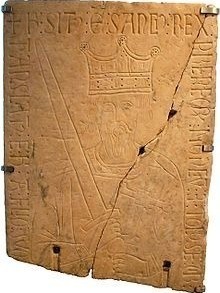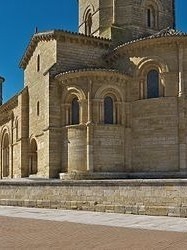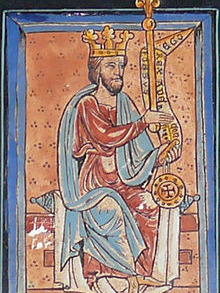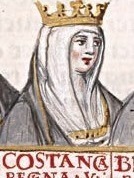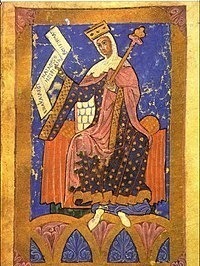Arbre généalogique Snelder - Versteegh » King Alfonso VI ("the brave") (Alfonso VI ("the brave")) of Leon and Castile (1040-1109)
Données personnelles King Alfonso VI ("the brave") (Alfonso VI ("the brave")) of Leon and Castile
Source 1- Prénom Alfonso VI ("the brave").
- Il est né en l'an 1040 dans Compostela, galicia, Spain.
- Il est décédé le 1 juillet 1109 dans Toledo, Castilla-La Mancha, Spain, il avait 69 ans.
- Un enfant de Ferdinand I of León of Leon and Castile et Sancha of Leon
Famille de King Alfonso VI ("the brave") (Alfonso VI ("the brave")) of Leon and Castile
Il est marié avec Constance of Burgundy.
Ils se sont mariés en l'an 1079, il avait 39 ans.
Enfant(s):
Barre chronologique King Alfonso VI ("the brave") (Alfonso VI ("the brave")) of Leon and Castile
Cette fonctionnalité n'est disponible que pour les navigateurs qui supportent Javascript.
Cliquez sur le nom pour plus d'information.
Symboles utilisés:  grand-parents
grand-parents
 parents
parents
 frères/soeurs
frères/soeurs
 enfants
enfants
 grand-parents
grand-parents
 parents
parents
 frères/soeurs
frères/soeurs
 enfants
enfants
Ancêtres (et descendants) de Alfonso VI ("the brave") of Leon and Castile
Alfonso VI ("the brave") of Leon and Castile 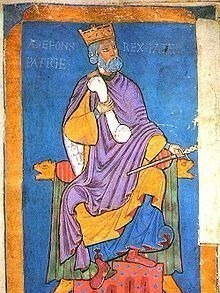 | ||||||||||||||||||||||||||||||||||
1079 | ||||||||||||||||||||||||||||||||||
Constance of Burgundy | ||||||||||||||||||||||||||||||||||
Les sources
- FamilySearch Stamboom, via https://www.myheritage.nl/research/colle...
Afonso VI of León and CastileOok bekend als: the Bravethe ValiantGeslacht: ManGeboorte: Tussen 1040 en 1041 - Compostela, galicia, SpainHuwelijk: Echtgeno(o)t(e): Constance of Burgundy - 1079Overlijden: 1 jul 1109 - Toledo, Castilla-La Mancha, SpainBegrafenis: Sahagún, León, Castilla y León, SpainVader: Ferdinand I of LeónEchtgenote(n/s): Constance of of León and Castile (geboren Burgundy), Isabella of León and CastileKinderen: Elvira of Castil Queen of Sicily, Urraca of Leon and Castile Aanvullende informatie:
LifeSketch: Alfonso VI (c.?1040/1041-1 July 1109), nicknamed the Brave (El Bravo) or the Valiant, was the son of King Ferdinand I of León and Queen Sancha, daughter of Alfonso V and sister of Bermudo III. He became king of León (1065-72) and of Galicia (1071-1109), and then king of the reunited Castile and León (1072-1109). After the conquest of Toledo in 1085, Alfonso proclaimed himself victoriosissimo rege in Toleto, et in Hispania et Gallecia (most victorious king of Toledo, and of Hispania and Galicia) The Battle of Sagrajas (1086) and the Battle of Uclés (1108), in which his only son and heir, Sancho Alfónsez died, constituted defeats for the Leonese and Castilian armies. «b»Life «/b» «b»Family and early years«/b» The son of Ferdinand I, King of León and Count of Castile and his wife, Queen Sancha, Alfonso was a "Leonese Infante with Navarrese and Castilian blood". His paternal grandparents were Sancho Garcés III, king of Pamplona and his wife Muniadona of Castile, and his maternal grandparents were Alfonso V of León (after whom he was probably named) and his first wife Elvira Menéndez. The year of Alfonso's birth is not recorded in medieval documentation. A contemporary text of the anonymous Chronicler of Sahagún, who met the monarch and was present when he died, relates that he died at age 62 after reigning 44 years, indicating that he was born in the second half of 1047 or in the first half of 1048. Bernard F. Reilly says he died at age 72, which would place his birth in 1037. According to the Historia silense, the eldest child of Ferdinand I and Sancha, a daughter called Urraca was born when her parents were still Counts of Castile, so her birth could be placed in 1033-34. The second child and eldest son, Sancho, would have been born in the second half of 1038 or in 1039. The third child and second daughter, Elvira may have been born in 1039-40, followed by Alfonso in 1040-41, and finally the youngest of the siblings, García, sometime between 1041 and 24 April 1043, the date on which King Ferdinand I, in a donation to the Abbey of San Andrés de Espinareda, mentions his five children. All of them, except Elvira, confirm a document in the monastery of San Juan Bautista de Corias on 26 April 1046. All the children of King Ferdinand I, according to the Historia silense, were educated in the liberal arts, and the sons were also trained in arms, the "art of running horses in the Spanish usage" and hunting. The cleric Raimundo was in charge of Alfonso's early education. Already king, Alfonso appointed him Bishop of Palencia and referred to him as magistro nostro, viro nobile et Deum timenti. Alfonso probably spent long periods in Tierra de Campos, where, along with Pedro Ansúrez, the son of Ansur Díaz and nephew of Count Gómez Díaz de Saldaña (both members of the Banu Gómez lineage), he learned the art of war and what was expected of a knight. «b»Ascension to the throne«/b» As the second son of the king of León and Count of Castile, Alfonso would not have been entitled to inherit the throne. At the end of 1063, probably on 22 December, taking advantage of the fact that numerous magnates had gathered in León, capital of the kingdom, for the consecration of the Basílica of San Isidoro, Ferdinand I summoned a Curia Regia to make known his testamentary dispositions, under which he decided to distribute his patrimony among his children, a distribution that would not become effective until the death of the monarch in order to prevent any disputes arising after his death: Alfonso inherited the Kingdom of León, "the most extensive, valuable and emblematic part: the one that contained the cities of Oviedo and León, cradles of the Asturian-Leonese monarchy", which included Asturias, León, Astorga, El Bierzo, Zamora with Tierra de Campos as well as the parias of the Taifa of Toledo. His elder brother, Sancho, was given the Kingdom of Castile, created by his father for him, and the parias of the Taifa of Zaragoza. His younger brother, García, received the entire region of Galicia, "elevated to the rank of kingdom" that extended south to the Mondego River in Portugal with the parias of the Taifa of Badajoz and Seville. Their sisters, Urraca and Elvira, both received the Infantazgo, that is, "the patronage and income of all the monasteries belonging to the royal patrimony" on the condition that they remained unmarried. The historian Alfonso Sánchez Candeira suggests that, although the reasons that led King Ferdinand I to divide the kingdom (with Alfonso VI inheriting the royal title) are unknown, probably the distribution was made because the king considered it proper that each son should inherit the region where he had been educated and spent his early years. «b»Reign «/b» «b»First part (1065-1072): Consolidation of the throne «/b» After his coronation in the city of León in January 1066, Alfonso VI had to confront the expansionist desires (although Alfonso would prove himself the same or more so) of his brother Sancho II, who, as the eldest son, considered himself the sole legitimate heir of all the kingdoms of their father. The conflicts began after the death of their mother Queen Sancha on 7 November 1067, leading to seven years of war between the three brothers. The first skirmish was the Battle of Llantada, a trial by ordeal in which both brothers agreed that the one who was victorious would obtain the kingdom of the defeated brother. Although Sancho II was the winner, Alfonso VI did not comply with the agreement; even so, relations between them remained cordial as evidenced by the fact that Alfonso was present at the wedding of Sancho II to an English noblewoman named Alberta on 26 May 1069. This was the same event where both decided to join forces to divide between themselves the Kingdom of Galicia that had been assigned to their younger brother García II. With the complicity of Alfonso VI, Sancho II invaded Galicia in 1071, defeating their brother García II who was arrested in Santarém and imprisoned in Burgos until he was exiled to the Taifa of Seville, then under the rule of Al-Mu'tamid ibn Abbad. After eliminating their brother, Alfonso VI and Sancho II titled themselves kings of Galicia and signed a truce that was maintained for three years. The truce was broken with the Battle of Golpejera on 12 January 1072. Although Sancho II's troops were victorious, he decided not to persecute his brother Alfonso, who was imprisoned in Burgos and later transferred to the monastery of Sahagún, where his head was shaved and he was forced to wear a chasuble. Thanks to the intercession of their sister Urraca, Sancho and Alfonso reached an agreement under which Alfonso VI was able to take refuge in the Taifa of Toledo under the protection of his vassal Al-Mamun, accompanied by his childhood friend, the faithful Pedro Ansúrez and his two brothers Gonzalo and Fernando. Alfonso VI, from his exile in Toledo, obtained the support of the Leonese nobility and his sister Urraca, who remained strong in the city of Zamora, a lordship that Ferdinand I had granted her previously. When Urraca refused to exchange Zamora for other cities that Sancho had offered her in an effort to control the fortress of Zamora, "key to the future expansion south of the Duero", Sancho besieged the city. However, during the siege, Sancho II was murdered. According to tradition, during the siege a nobleman named Vellido Dolfos appeared before the king, claiming to have changed his loyalty from Urraca to Sancho. Under the pretense of showing him the weak parts of the city's walls, Dolfos separated the king from his guard and killed him with a spear. Although there is no clear evidence that Sancho II's death was due to treason rather than deceit, since Dolfos was Sancho II's enemy, his murder occurred in a warlike attack during the siege, not near the city walls, but rather in a nearby forest where Dolfos lured the Castilian king away from his armed protection.[clarification needed] The violent death of Sancho II, who had no descendants, allowed Alfonso VI to reclaim his throne as well as Sancho's and Garcia's original inheritances of Castile and Galicia, respectively. Although Rodrigo Díaz de Vivar, the standard-bearer and confidant of King Sancho II, was present at the siege of Zamora, the role he played in this event is not known. Neither can Sancho II's death be blamed on Alfonso VI, who, when his brother was killed, was in exile far from the events. "nevertheless, the minstrels and ballads filled this void with beautiful literary creations devoid of any historical reality". It was at this time that the Leyenda de Cardeña concerning El Cid (13th century) was born. According to this legend, Alfonso VI was forced by El Cid to take an oath to deny that he had been involved in his brother's death, thus giving rise to mutual distrust between them despite Alfonso VI's efforts at rapprochement by offering his niece Jimena Díaz to El Cid in marriage as well as the immunity of his patrimony. These events and their consequences would eventually come to be considered historical by many later chroniclers and historians, however, most modern historians reject the contention that this episode actually took place. Sancho II's death was also used by García II to regain his own throne. However, the following year, on 13 February 1073, Alfonso summoned García to a meeting, whereupon Alfonso captured and imprisoned his younger brother. He held him at the castle of Luna, for seventeen years, where he eventually died on 22 March 1090. With his two brothers out of the way, Alfonso VI had no problem in securing the loyalty of both the high clergy and the nobility of their territories; to confirm this, he spent the next two years visiting them. «b»Second part (1072-1086): Territorial expansion«/b» Now established on the Leonese throne, and with the title of "Emperor", a relic of the Gothic tradition, Alfonso VI spent theDe FamilySearch Stamboom wordt gepubliceerd door MyHeritage onder licentie van FamilySearch International, de grootste genealogische organisatie in de wereld. FamilySearch is een nonprofit organisatie die gespnsord wordt door The Church of Jesus Christ of Latter-day Saints (Mormon Church).
Même jour de naissance/décès
- 1277 » Baybars, sultan mamelouk d'Égypte (° vers 1223).
- 1523 » Henri Voes et Jean Van Eschen, moines, brûlés vifs à Bruxelles (° non précisées, ni l'une ni l'autre).
- 1614 » Isaac Casaubon, humaniste français (° 18 février 1559).
- 1766 » François-Jean Lefebvre de La Barre, noble français (° 12 septembre 1746).
- 1784 » Wilhelm Friedemann Bach, organiste et compositeur allemand (° 22 novembre 1710).
- 1860 » Charles Goodyear, chimiste américain, inventeur du procédé de vulcanisation (° 29 décembre 1800).
Sur le nom de famille Of Leon and Castile
- Afficher les informations que Genealogie Online a concernant le patronyme Of Leon and Castile.
- Afficher des informations sur Of Leon and Castile sur le site Archives Ouvertes.
- Trouvez dans le registre Wie (onder)zoekt wie? qui recherche le nom de famille Of Leon and Castile.
La publication Arbre généalogique Snelder - Versteegh a été préparée par Roel Snelder.
Lors de la copie des données de cet arbre généalogique, veuillez inclure une référence à l'origine:
Roel Snelder, "Arbre généalogique Snelder - Versteegh", base de données, Généalogie Online (https://www.genealogieonline.nl/stamboom-snelder-versteegh/I506195.php : consultée 11 mai 2024), "King Alfonso VI ("the brave") (Alfonso VI ("the brave")) of Leon and Castile (1040-1109)".
Roel Snelder, "Arbre généalogique Snelder - Versteegh", base de données, Généalogie Online (https://www.genealogieonline.nl/stamboom-snelder-versteegh/I506195.php : consultée 11 mai 2024), "King Alfonso VI ("the brave") (Alfonso VI ("the brave")) of Leon and Castile (1040-1109)".
